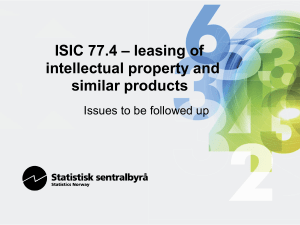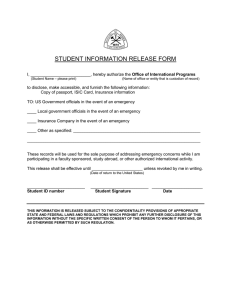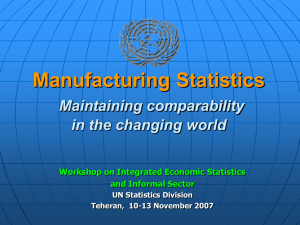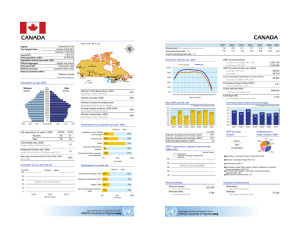ISIC Rev.4 Main concepts and application rules United Nations Statistics Division
advertisement
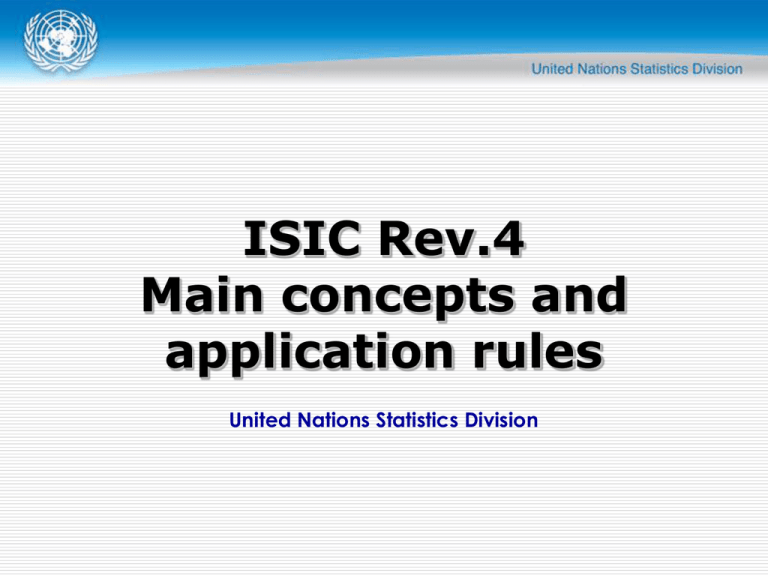
ISIC Rev.4 Main concepts and application rules United Nations Statistics Division Objectives of the ISIC revision Relevance Reflect new industries, new production pattern, new needs for economic analysis Comparability Improve linkages to major regional classifications Continuity Maintain close links to the previous version of ISIC Main task: balancing these three objectives ISIC structure changes Increase in top-level categories Increase in overall detail New concepts (information, professional services, support services) New application rules (vertical integration, top-down method, outsourcing) This presentation provides an overview. Specific sections will be discussed separately. High-level concordance ISIC Rev.3.1 A Agriculture, hunting and forestry ISIC Rev.4 A Agriculture, forestry and fishing B Mining and quarrying C Manufacturing B Fishing C Mining and quarrying D Manufacturing D Electricity, gas, steam … E Water supply; sewerage, waste … F Construction E Electricity, gas and water supply G Wholesale and retail trade; … F H Transportation and storage Construction G Wholesale and retail trade; … I Accommodation and food service activities H Hotels and restaurants J Information and communication I Transport, storage and communications K Financial and insurance activities J Financial intermediation K Real estate, renting and business … L Public administration … M Education L Real estate activities M Professional, scientific and technical activities N Administrative and support service activities O Public administration … P Education N Health and social work Q Human health and social work activities O Other community, social, personal … R Arts, entertainment and recreation P Activities of private households S Other service activities Q Extraterritorial organizations and bodies T Activities of households … U Activities of extraterritorial organizations … Increased detail of ISIC Rev.4 ISIC Rev.3 ISIC Rev.4 Sections 17 21 Divisions 60 88 Groups 159 238 Classes 292 419 Main principles ISIC classifies statistical units according to their principal activity Units Theoretically, all types of units can be classified However, structure and detail of ISIC is geared toward measuring production and establishment and kind-of-activity unit are the most suitable units Ideally, units should be homogeneous with respect to activities and location However, the choice of unit is not really an ISIC issue Limitations are often set by data availability Main principles “Activity” Classification of units is based on their actual activity, not their appearance or setup E.g. a shipyard that only dismantles ships is classified in 3830 according to its activity (ship-breaking), although similar-looking units are in 3011. Activity is defined through inputs, process and outputs Main principles “Similar” activities are grouped together Similarity is based on the three defining components for activities However, at lowest level, emphasis is given to similarities in the process At higher levels, the analytical use of the categories becomes more important A strict application of a ranking of the three defining components would often lead to categories that are not useful (e.g. by process in manufacturing) A pragmatic approach of applying the criteria for grouping has been maintained, as in previous versions of ISIC Main principles Although output (products) is related to the activity, it can not always be used to determine the activity of a unit Will be discussed separately in ISIC-CPC link topic However, with some caveats, it provides a good tool Classes of ISIC are defined so that as far as possible the following two conditions are fulfilled: (a) The production of the category of goods and services that characterizes a given class accounts for the bulk of the output of the units classified to that class; (b) The class contains the units that produce most of the category of goods and services that characterize it. Main principles Since a unit can carry out several activities, rules are necessary to identify the primary activity of a given unit This still requires knowledge about the individual activities (elementary activities) of a unit
